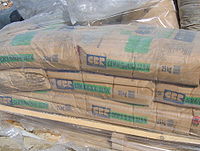
Photo from wikipedia
Abstract The comprehensive utilization of wasted pickling sludge in the cement kiln would be a promising practice, but the calcination process of cement clinker became complicated due to the simultaneous… Click to show full abstract
Abstract The comprehensive utilization of wasted pickling sludge in the cement kiln would be a promising practice, but the calcination process of cement clinker became complicated due to the simultaneous introduction of titanium and fluorine. In this paper, the formation and hydration of tricalcium silicate (C3S) doped with CaF2 and TiO2 were discerned by XRD, FT-IR, XPS and isothermal calorimetry. The results revealed that the addition of CaF2 more than 1.5% would promote the appearance of CaTiO3 as the indicator of the solution limit of TiO2, and the formation of CaTiO3 and β-C2S was a concomitant process as the solution limit of TiO2 reached. The addition of 0.5% TiO2 and some addition of CaF2 (≤1.5%) would reduce the polymorph symmetry of C3S, while more addition of CaF2 and TiO2 would actualize the higher polymorph symmetry from M1 to R form. The IR spectra for the polymorphs (T3, M3, R + M3, R) became broader with the increase of the polymorph symmetry of C3S. The replacement of O2− by F− would not be interfered by the simultaneous introduction of titanium, a Ti2p 1/2 peak at 463.39 eV reflected the solution of titanium in the structure of C3S, and the defect reactions of the doped C3S with CaF2 and TiO2 were proposed. The doped C3S had a higher heat flow than the undoped C3S in the initial period, the more addition of CaF2 inhibited the initial hydration activity of C3S, while the addition of TiO2 improved the effect. The incorporation of TiO2 into the doped C3S aggravated the retardation effect caused by CaF2 on the hydration in the acceleration period. The dopant types displayed a more distinct effect than the types of C3S polymorphs on the hydration activity of C3S.